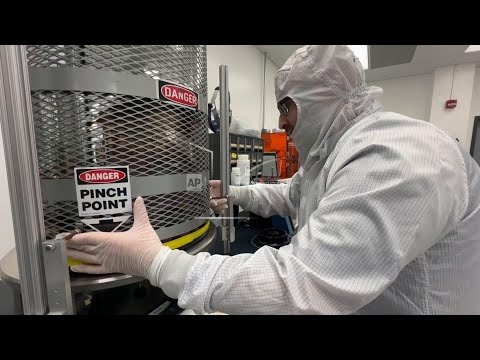(21 Apr 2025)
RESTRICTION SUMMARY:
ASSOCIATED PRESS
Henrietta, New York – 14 April 2025
1. Karl Hirschman with silicon wafers
2. Various of Eli Powell, RIT Microsystems Engineering PhD Student, removing silicon wafer from machine after it has been patterned with microchip microprocessors
++PARTLY COVERED++
3. SOUNDBITE (English) Karl Hirschman, RIT Microelectronic Engineering Program Director:
“I think that we are doing a tremendous service to students to get them involved in this program because of the opportunities, the jobs that are going to be available, and just the excitement that this field has. I wish we could double our enrollment. That would be great because our semiconductor companies that hire at RIT, they come to our career fair. We have a dozen or so companies come twice a year and we don’t have enough resumes to provide these companies.”
4. Students in “bunny suits” in microchip lab
++PARTLY COVERED++
5. SOUNDBITE (English) Eli Powell, RIT Microsystems Engineering PhD Student:
“We are always going to need microelectronic engineering for the future. They can have AI and robots take away the manufacturing jobs, but they’ll never actually be able to make the actual devices and the theories behind everything, so we will always need people doing the research.”
6. Microchips and microscope
7. People in lab
8. Various of RIT lecturer Stephanie Bolster speaks to class
9. RIT campus with sign
++COVERED++
10. SOUNDBITE (English) Matt Lynch, RIT Microelectronic Engineering Undergraduate Student:
“I definitely want to go into a manufacturing environment. Hopefully work to help make chip production better, cheaper, faster, simpler."
++PARTLY COVERED++
11. SOUNDBITE (English) Matt Lynch, RIT Microelectronic Engineering Undergraduate Student:
“We’re putting chips into more and more products every day. And so, in long- term, we’re going to need to be producing a lot more chips, and that means we’re gonna need a lot of more trained engineers to make them. So I think no matter what happens the next couple of months, over the next few years, I think the prospects are looking pretty good.”
12. Individual microchip
13. Potential students touring RIT semiconductor lab building
14. Multiple microchips patterned on a silicon wafer
STORYLINE:
The faculty at the Rochester Institute of Technology’s microelectronic engineering program wish they could double enrollment in their microchip-making training program. And that more schools would teach the specialty to meet the need for a skilled domestic workforce to run fabrication plants in the United States.
Students in the five-year undergraduate program build microchips in the school’s lab, parts of which are yellow as all traces of bluish daylight are removed as part of the fabrication process.
In the commercial world, the process of patterning microchips onto semiconductor silicon wafers is done automatically, with engineers only intervening when something needs to be fixed or adjusted.
At RIT, students learn hands-on the whole process of designing and patterning the tiny transistor devices that run modern society’s smart phones, vehicles, computers and weapons systems.
One hundred students are currently enrolled in RIT’s microengineering program, which is one of handful of universities in the country that teach the specialty.
RIT started the microelectronics program in 1982, as a sub-discipline of electrical engineering. The school says 100 percent of its microengineering graduates are hired, and are usually recruited and made offers before they even graduate.
Find out more about AP Archive: http://www.aparchive.com/HowWeWork
Twitter: https://twitter.com/AP_Archive
Facebook: https://www.facebook.com/APArchives
Instagram: https://www.instagram.com/APNews/
You can license this story through AP Archive: http://www.aparchive.com/metadata/youtube/6b5a31ca14184ccc9be792153e469557
Author: AP Archive
Go to Source
News post in April 26, 2025, 9:05 pm.
Visit Our Sponsor’s:
News Post In – News





